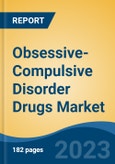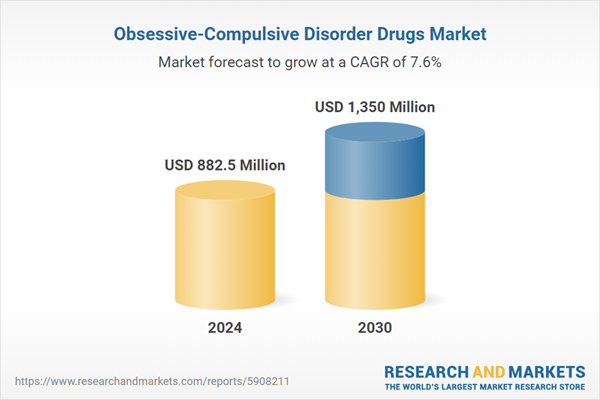Speak directly to the analyst to clarify any post sales queries you may have.
10% Free customizationThis report comes with 10% free customization, enabling you to add data that meets your specific business needs.
adults had OCD in the past year, with a higher prevalence in females (1.8%) compared to males (0.5%). Obsessive-compulsive disorder is a condition that causes a person to get fixated on a certain idea or fear. Numerous further prospects in the market for OCD medications are anticipated to arise because of recent improvements in therapy, therapies, and innovative treatments as well as in anti-anxiety, antipsychotic, and antidepressant medications. However, the introduction of generic versions of branded medications and the patent expiration of patented ones are two factors anticipated to impede market development over the projection period.
Key Market Drivers
Increasing Prevalence of OCD
Increased awareness campaigns, both online and offline, have educated the public and healthcare professionals about the symptoms of OCD. As people become more informed, they are more likely to seek help and receive a diagnosis. For instance, according to a January 2022 research article, fluvoxamine, a selective serotonin reuptake inhibitor (SSRI) approved for obsessive-compulsive disorder, has shown potential therapeutic benefits for COVID-19 based on multiple studies. This highlights its emerging role beyond mental health treatment.Additionally, according to WHO data updated in September 2021, depression affects approximately 5% of adults globally and is the leading cause of disability worldwide. This high prevalence drives demand for antidepressants, significantly contributing to market growth as more individuals seek effective treatment options.
Advances in the understanding of OCD have led to more precise diagnostic criteria. This has enabled healthcare providers to identify OCD in individuals who might have previously been misdiagnosed or undiagnosed. Efforts to reduce the stigma associated with mental health conditions have been ongoing. As stigma decreases, individuals are more willing to talk openly about their symptoms and seek treatment without fear of discrimination. In some healthcare settings, routine mental health screenings are becoming more common.
This proactive approach can lead to the identification of individuals with OCD who may not have sought help otherwise. OCD often co-occurs with other mental health disorders, such as depression and anxiety. As these comorbid conditions are better recognized and treated, individuals with OCD may also receive a diagnosis and appropriate treatment. Events such as the COVID-19 pandemic have drawn attention to mental health issues, including OCD. The pandemic's impact on mental health has led to increased recognition of OCD symptoms in affected individuals.
Key Market Challenges
Comorbid Conditions
Individuals with comorbid conditions often require more complex treatment plans. When OCD is accompanied by other psychiatric disorders like depression, anxiety, or substance abuse, healthcare providers need to consider how these conditions interact and choose medications that can effectively address multiple symptoms. This complexity can lead to challenges in finding the right combination of drugs. Polypharmacy, the use of multiple medications concurrently, may be necessary for individuals with comorbid conditions. This can increase the risk of drug interactions, adverse effects, and medication non-adherence. Healthcare providers must carefully manage medication regimens to optimize treatment outcomes.Comorbid conditions can lead to variations in treatment responses. What works well for one condition may not be as effective for another. Finding medications that are both safe and effective across multiple conditions can be a challenge. Treating individuals with comorbid conditions often involves more frequent healthcare visits, medication management, and therapy sessions.
These increased healthcare costs can impact both individuals and healthcare systems, potentially affecting the demand for OCD drugs. The presence of comorbid conditions can complicate the diagnostic process. Symptoms of one condition may mask or mimic those of another, leading to potential misdiagnoses. Accurate diagnosis is essential for tailoring treatment plans. In cases of comorbidity, healthcare providers must prioritize which condition to address first. For example, if a patient has both OCD and a substance use disorder, it may be necessary to treat the substance use disorder before addressing the OCD symptoms effectively.
Key Market Trends
Stigma Reduction
Reduced stigma encourages earlier intervention, which can lead to better treatment outcomes. When individuals seek help at the onset of symptoms, their conditions may be more manageable, potentially reducing the overall duration of treatment and the need for more intensive interventions. Stigma can be a barrier to medication adherence. When individuals are more open about their mental health conditions and receive support from their social networks, they may be more likely to adhere to their treatment plans, including taking prescribed OCD medications consistently. Stigma reduction efforts can lead to increased support for mental health services, including access to psychiatrists, therapists, and medication management.This expansion of services benefits individuals seeking treatment for OCD. When individuals with OCD feel less stigmatized, they may become more empowered to actively participate in their treatment decisions. This can lead to more collaborative and effective treatment plans, including medication choices. Stigma reduction often goes hand in hand with advocacy and support efforts. Patient advocacy groups and mental health organizations play a crucial role in raising awareness, destigmatizing mental health conditions, and advocating for improved access to mental health services and treatments. As stigma diminishes, there is a greater opportunity for the integration of mental health services into primary care settings. This can improve the identification and management of mental health conditions like OCD, potentially leading to more individuals receiving treatment.
Key Market Players
- Abbott SA
- Eli Lilly, and Company
- Viatria Inc.
- H. LUNDBECK A/S,
- GlaxoSmithKline plc
- Pfizer Inc.
- Zydus Pharmaceuticals, Inc.
- Lupin Pharmaceuticals, Inc.
- Amneal Pharmaceuticals LLC
- Teva Pharmaceutical industries Ltd.
Report Scope:
In this report, the Global Obsessive-Compulsive Disorder Drugs Market has been segmented into the following categories, in addition to the industry trends which have also been detailed below:Obsessive-Compulsive Disorder Drugs Market, By Type:
- SSRI (Selective Serotonin Reuptake Inhibitors)
- TCA (Tricyclic Antidepressant)
Obsessive-Compulsive Disorder Drugs Market, By Application:
- Research Institute
- Hospitals & Clinics
- Others
Obsessive-Compulsive Disorder Drugs Market, By region:
- North America
- United States
- Canada
- Mexico
- Asia-Pacific
- China
- India
- South Korea
- Australia
- Japan
- Europe
- Germany
- France
- United Kingdom
- Spain
- Italy
- South America
- Brazil
- Argentina
- Colombia
- Middle East & Africa
- South Africa
- Saudi Arabia
- UAE
Competitive Landscape
Company Profiles: Detailed analysis of the major companies present in the Global Obsessive-Compulsive Disorder Drugs Market.Available Customizations:
With the given market data, the publisher offers customizations according to a company's specific needs. The following customization options are available for the report.Company Information
- Detailed analysis and profiling of additional market players (up to five).
This product will be delivered within 1-3 business days.
Table of Contents
Companies Mentioned
- Abbott SA
- Eli Lilly, and Company
- Viatria Inc.
- H. LUNDBECK A/S,
- GlaxoSmithKline plc
- Pfizer Inc.
- Zydus Pharmaceuticals, Inc.
- Lupin Pharmaceuticals, Inc.
- Amneal Pharmaceuticals LLC
- Teva Pharmaceutical industries Ltd.
Table Information
| Report Attribute | Details |
|---|---|
| No. of Pages | 180 |
| Published | March 2025 |
| Forecast Period | 2024 - 2030 |
| Estimated Market Value ( USD | $ 882.5 Million |
| Forecasted Market Value ( USD | $ 1350 Million |
| Compound Annual Growth Rate | 7.6% |
| Regions Covered | Global |
| No. of Companies Mentioned | 10 |









